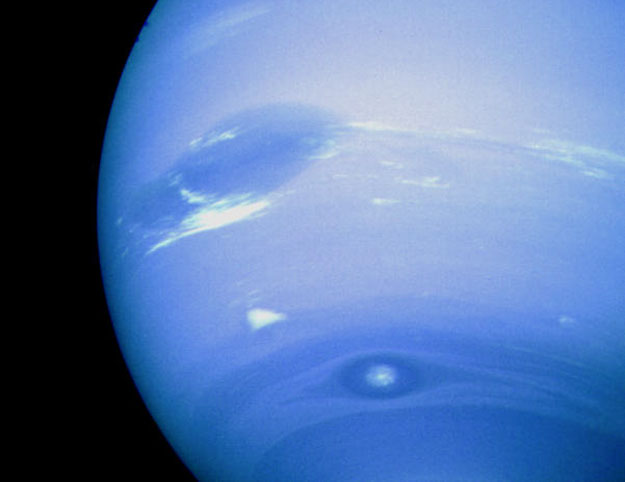Credit: Voyager 2 Team,
NASA
Explanation:
Neptune has spots.
The Solar System's outermost gas giant shows a
nearly uniform blue hue created by small amounts of
methane drifting in a thick atmosphere of
nearly colorless
hydrogen and
helium.
Dark spots do appear, however, that are
anti-cyclones:
large high-pressure systems that swirl in
Neptune's cold cloud tops.
Two dark spots are visible in the
above picture taken by the robot
Voyager 2 spacecraft in 1989: an
Earth-sized
Great Dark Spot located on the far left, and
Dark Spot 2 located near bottom.
A bright cloud dubbed
Scooter accompanies the Great Dark Spot.
Recent computer simulations indicate that
scooters are methane clouds that might commonly
be found near dark spots.
Subsequent
images of
Neptune by the
Hubble Space Telescope
in 1994 indicated that both of these
dark spots had dissipated, but
another had been created.
1999 2000 2001 2002 2003 2004 2005 2006 2007 2008 2009 2010 2011 2012 2013 2014 2015 2016 2017 2018 2019 2020 2021 2022 2023 2024 2025 |
Январь Февраль Март Апрель Май Июнь Июль Август Сентябрь Октябрь Ноябрь Декабрь |
NASA Web Site Statements, Warnings, and Disclaimers
NASA Official: Jay Norris. Specific rights apply.
A service of: LHEA at NASA / GSFC
& Michigan Tech. U.
|
Публикации с ключевыми словами:
Нептун - солнечная система - Neptune - Solar System
Публикации со словами: Нептун - солнечная система - Neptune - Solar System | |
См. также:
Все публикации на ту же тему >> | |
